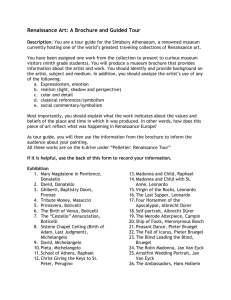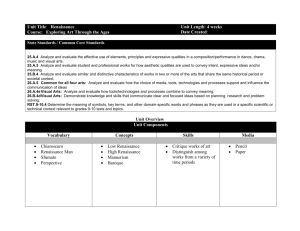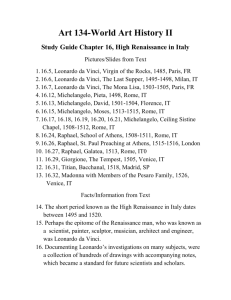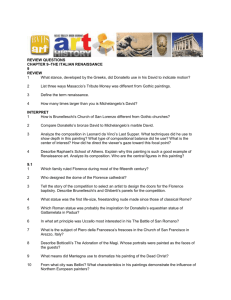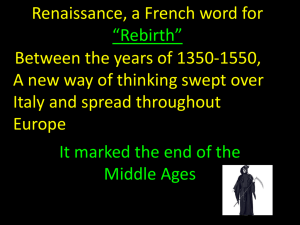the renaissance - alex miles orellana
advertisement
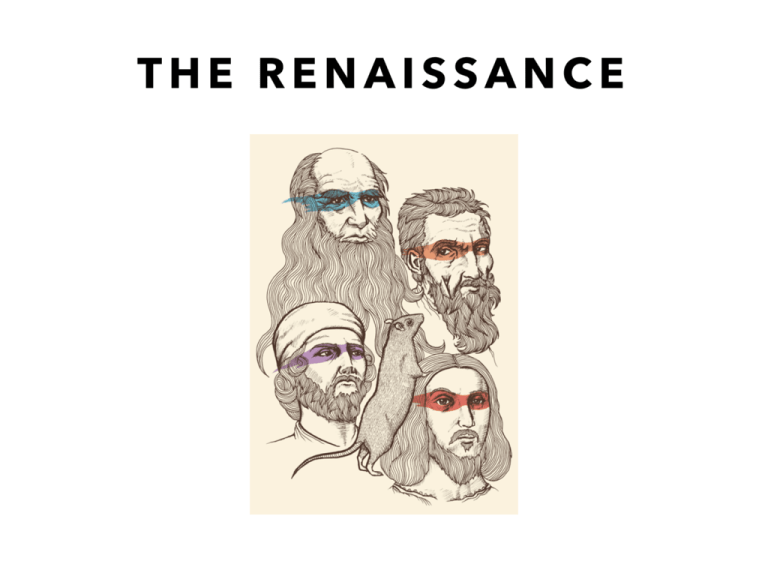
THE RENAISSANCE The Book Of Hours: Autumn Months Limbourg Brothers GOTHIC YIELDS TO THE RENAISSANCE • figures start to look like real people, displaying real emotions • naturalistic representation (this is found in Gothic art / architecture, and even more so in Renaissance) • if the figures in the Reims portal (Gothic Cathedral) seem to about to step off their columns, Renaissance figures actually do so • for the first time since classical antiquity, human beings are represented as casting actual shadows on the ground • actual space is rendered (perspective) THE RENAISSANCE • Renaissance means REBIRTH • in Europe, toward the end of the thirteenth century, a new kind of art began to appear, at first in the south, and somewhat later in the north • by the beginning of the fifteenth century, this new era, marked by a revival of interest in arts and sciences that had been lost since antiquity, was firmly established • ITALIAN RENAISSANCE : 1300s - 1500s • HIGH RENAISSANCE : 1490’s - 1527 • NORTHERN RENAISSANCE : 1497 – 1500s DONATELLO • c. 1386 – 1466 • the most important early Renaissance sculptor in Florence David Donatello c. 1425 - 30 BOTICELLI • c. 1445 – 1510 • painted in the style of Early Renaissance • worked under the patronage of Lorenzo de’ Medici Primavera Boticelli 1482 Birth of Venus Boticelli c. 1482 - 1485 HIGH RENAISSANCE • began around the 1490’s and ended around 1527 • the start date is attributed to da Vinci’s Last Supper and the death of Lorenzo de’ Medici (an extremely wealthy patron of the arts, especially for Botticelli and Michelangelo) • the end date is specific due to the sacking of Rome in 1527 • the visual arts of the High Renaissance were marked by a renewed emphasis upon the classical tradition, the expansion of networks of patronage, and a gradual attention of figural forms into the style later termed Mannerism (Wikipedia) LEONARDO DA VINCI • 1452 - 1519 • painter, sculptor, engineer, cartographer, inventor • credited with the inventions of the parachute, tank, and helicopter • widely considered to be the most diversely talented person ever to have lived in the Western world as well as one of the greatest painters of all time (Wikipedia) Vitruvian Man Leonardo da Vinci c. 1492 Annunciation Leonardo da Vinci 1475 – 1480 Tank Leonardo da Vinci 1487 Backwards Writing Leonardo da Vinci The Last Supper Leonardo da Vinci 1520 Mona Lisa Leonardo da Vinci 1503 – 1507 Lady with Ferret Leonardo da Vinci 1489 - 1490 RAPAHEL • 1483 – 1520 • Learned from both Leonardo and Michelangelo • in 1508 was awarded the largest commissions of the day, the decoration of the papal apartments at the Vatican in Rome • on the four walls of the first room, the Stanza della Segnatura, he painted frescoes representing the four domains of knowledge – Theology, Law, Poetry, and Philosophy • the most famous of these is the last, The School of Athens (1509 -1511) PLATO ARISTOTLE Concerned with the spiritual world of Ideas (he is pointing upwards). Concerned with the matter-of-factness of material reality (he is pointing over the ground upon which he walks). MICHELANGELO Portrayed as the philosopher Heraclitus, the brooding, selfabsorbed figure in the foreground. Small Cowper Madonna Raphael 1505 Madonna of the Meadows Raphael 1506 Madonna Sixtina Raphael 1513 - 14 NORTHERN RENAISSANCE • Renaissance that occurred in Europe north of the Alps • before 1497, Italian Renaissance humanism had little influence outside of Italy • from the late 15th century, its ideas spread around Europe NORTHERN RENAISSANCE • this influenced the German Renaissance, French Renaissance, English Renaissance, Renaissance in the Low Countries (Belgium, Netherlands, French Flanders), Polish Renaissance (Wikipedia) PETER BRUEGEL THE ELDER • c. 1525 - 1569 • Dutch Renaissance Painter known for his Genre Painting (scenes of daily life) • in 1565, Bruegel was commissioned to make a series of paintings portraying each month of the year • today, few of these paintings survive and some of the months are paired to form a general season (Wikipedia) The Parable of the Blind Leading the Blind Peter Bruegel the Elder 1568 The Hunters in Snow (January) Peter Bruegel the Elder 1565 Gloomy Day (February) Peter Bruegel the Elder 1565 The Return of the Herd (November) Peter Bruegel the Elder 1565 MICHELANGELO • 1475 - 1564 • identified as a sculptor • on May 10, 1506, Michelangelo received an advance payment from Pope Julius II to undertake the task of frescoing the ceiling of the Sistine Chapel at the Vatican in Rome • by the end of July, a scaffolding had been erected MICHELANGELO • by September of 1508, Michelangelo was painting, and for the next four and a half years, he worked almost without interruption on the project Pieta Michelangelo 1498 – 99 David Michelangelo 1501 - 04 The Sistine Chapel Michelangelo c. 1508 - 1512 Creation of Adam Michelangelo c. 1511 - 1512 Studies for the Libyan Sibyl Michelangelo c. 1510 The Libyan Sibyl Michelangelo c. 1510 The Sistine Chapel : The Last Judgement Michelangelo 1534 - 41 MEANING IN THE LAST JUDGEMENT • figures of grotesque proportion arranged in an almost chaotic, certainly athletic, swirl of line • this piece, in particular, is a nod to the shift in visual preferences - from the High Renaissance feelings of “balance and proportion” to a mannered, “consciously artificial,” and stylized approach in Mannerism This remnant of a person is supposedly Michelangelo himself. MANNERISM • started in Italy around 1520, after Raphael’s death • highly individualistic and mannered (consciously artificial) • dedicated to “invention” – the technical and imaginative virtuosity of the artist became paramount importance • colors are often bright and clashing • more than one focal point might be utilized, making a rather contradictory scene Madonna with the Long Neck Parmigianino 1534 - 1535 Deposition from the Cross Pontormo 1525 - 1528 Venus, Cupid, Folly, and Time (Allegory of Lust) Bronzino c. 1545 TIME FRAUD AND OBLIVION CUPID VENUS JEALOUSY, DESPAIR, AND THE EFFECTS OF SYPHILIS JEST, FOLLY, PLEASURE The Burial of Count Orgaz El Greco (“The Greek”) 1586


